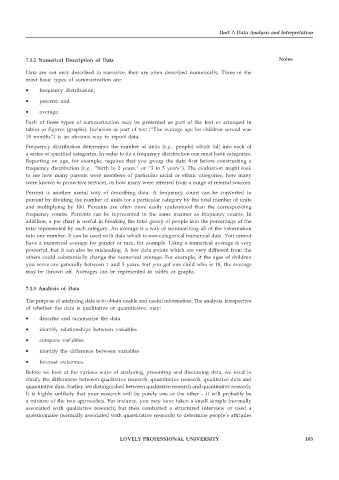Page 108 - DLIS401_METHODOLOGY_OF_RESEARCH_AND_STATISTICAL_TECHNIQUES
P. 108
Unit 7: Data Analysis and Interpretation
7.1.2 Numerical Description of Data Notes
Data are not only described in narrative, they are often described numerically. Three of the
most basic types of summarization are:
• frequency distribution;
• percent; and
• average.
Each of these types of summarization may be presented as part of the text or arranged in
tables or figures (graphs). Inclusion as part of text (“The average age for children served was
18 months”) is an obvious way to report data.
Frequency distribution determines the number of units (e.g., people) which fall into each of
a series of specified categories. In order to do a frequency distribution one must have categories.
Reporting on age, for example, requires that you group the data first before constructing a
frequency distribution (e.g., “birth to 2 years,” or “3 to 5 years”). The evaluation might look
to see how many parents were members of particular racial or ethnic categories, how many
were known to protective services, or how many were referred from a range of referral sources.
Percent is another useful way of describing data. A frequency count can be converted to
percent by dividing the number of units for a particular category by the total number of units
and multiplying by 100. Percents are often more easily understood than the corresponding
frequency counts. Percents can be represented in the same manner as frequency counts. In
addition, a pie chart is useful in breaking the total group of people into the percentage of the
total represented by each category. An average is a way of summarizing all of the information
into one number. It can be used with data which is non-categorical numerical data. You cannot
have a numerical average for gender or race, for example. Using a numerical average is very
powerful, but it can also be misleading. A few data points which are very different from the
others could substantially change the numerical average. For example, if the ages of children
you serve are generally between 1 and 3 years, but you get one child who is 18, the average
may be thrown off. Averages can be represented in tables or graphs.
7.1.3 Analysis of Data
The purpose of analysing data is to obtain usable and useful information. The analysis, irrespective
of whether the data is qualitative or quantitative, may:
• describe and summarise the data
• identify relationships between variables
• compare variables
• identify the difference between variables
• forecast outcomes.
Before we look at the various ways of analysing, presenting and discussing data, we need to
clarify the differences between qualitative research, quantitative research, qualitative data and
quantitative data. Earlier, we distinguished between qualitative research and quantitative research.
It is highly unlikely that your research will be purely one or the other – it will probably be
a mixture of the two approaches. For instance, you may have taken a small sample (normally
associated with qualitative research) but then conducted a structured interview or used a
questionnaire (normally associated with quantitative research) to determine people’s attitudes
LOVELY PROFESSIONAL UNIVERSITY 103

